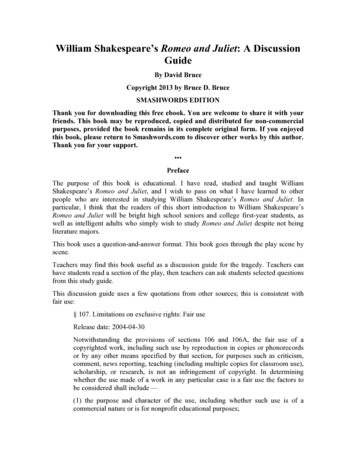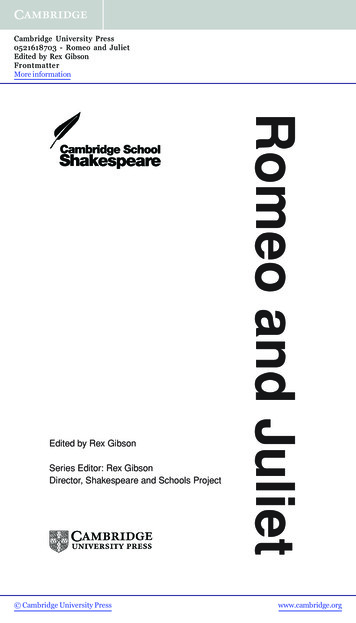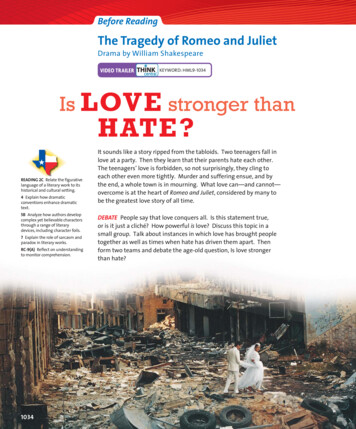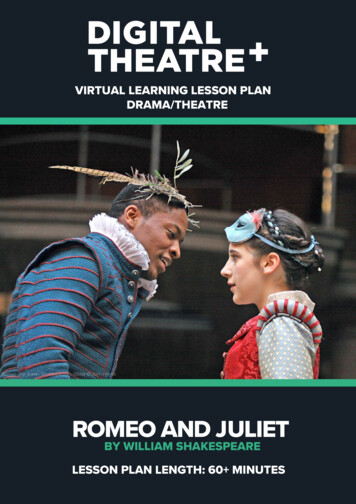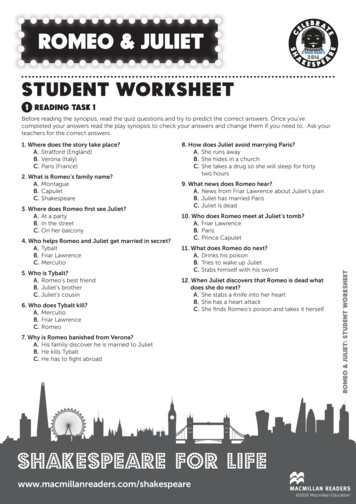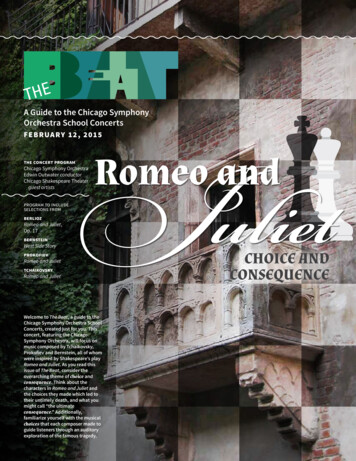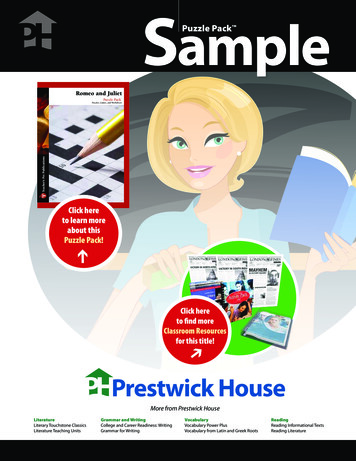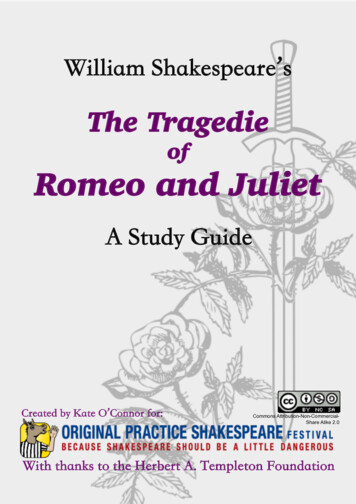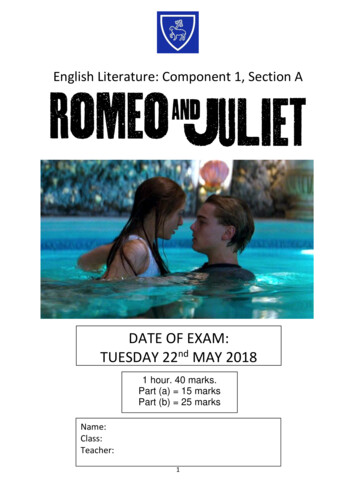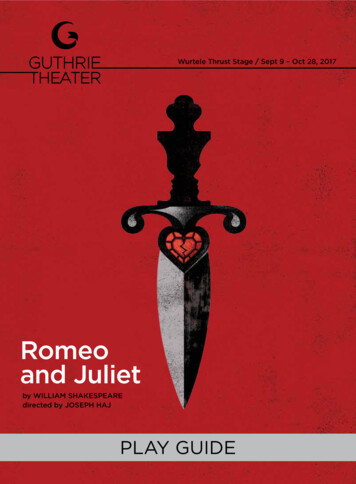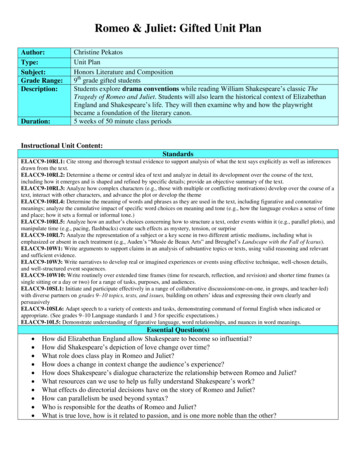
Transcription
Romeo & Juliet: Gifted Unit PlanAuthor:Type:Subject:Grade Range:Description:Duration:Christine PekatosUnit PlanHonors Literature and Composition9th grade gifted studentsStudents explore drama conventions while reading William Shakespeare’s classic TheTragedy of Romeo and Juliet. Students will also learn the historical context of ElizabethanEngland and Shakespeare’s life. They will then examine why and how the playwrightbecame a foundation of the literary canon.5 weeks of 50 minute class periodsInstructional Unit Content:StandardsELACC9-10RL1: Cite strong and thorough textual evidence to support analysis of what the text says explicitly as well as inferencesdrawn from the text.ELACC9-10RL2: Determine a theme or central idea of text and analyze in detail its development over the course of the text,including how it emerges and is shaped and refined by specific details; provide an objective summary of the text.ELACC9-10RL3: Analyze how complex characters (e.g., those with multiple or conflicting motivations) develop over the course of atext, interact with other characters, and advance the plot or develop the themeELACC9-10RL4: Determine the meaning of words and phrases as they are used in the text, including figurative and connotativemeanings; analyze the cumulative impact of specific word choices on meaning and tone (e.g., how the language evokes a sense of timeand place; how it sets a formal or informal tone.)ELACC9-10RL5: Analyze how an author’s choices concerning how to structure a text, order events within it (e.g., parallel plots), andmanipulate time (e.g., pacing, flashbacks) create such effects as mystery, tension, or surpriseELACC9-10RL7: Analyze the representation of a subject or a key scene in two different artistic mediums, including what isemphasized or absent in each treatment (e.g., Auden’s “Musée de Beaux Arts” and Breughel’s Landscape with the Fall of Icarus).ELACC9-10W1: Write arguments to support claims in an analysis of substantive topics or texts, using valid reasoning and relevantand sufficient evidence.ELACC9-10W3: Write narratives to develop real or imagined experiences or events using effective technique, well-chosen details,and well-structured event sequences.ELACC9-10W10: Write routinely over extended time frames (time for research, reflection, and revision) and shorter time frames (asingle sitting or a day or two) for a range of tasks, purposes, and audiences.ELACC9-10SL1: Initiate and participate effectively in a range of collaborative discussions(one-on-one, in groups, and teacher-led)with diverse partners on grades 9–10 topics, texts, and issues, building on others’ ideas and expressing their own clearly andpersuasivelyELACC9-10SL6: Adapt speech to a variety of contexts and tasks, demonstrating command of formal English when indicated orappropriate. (See grades 9–10 Language standards 1 and 3 for specific expectations.)ELACC9-10L5: Demonstrate understanding of figurative language, word relationships, and nuances in word meanings. Essential Question(s)How did Elizabethan England allow Shakespeare to become so influential?How did Shakespeare’s depiction of love change over time?What role does class play in Romeo and Juliet?How does a change in context change the audience’s experience?How does Shakespeare’s dialogue characterize the relationship between Romeo and Juliet?What resources can we use to help us fully understand Shakespeare’s work?What effects do directorial decisions have on the story of Romeo and Juliet?How can parallelism be used beyond syntax?Who is responsible for the deaths of Romeo and Juliet?What is true love, how is it related to passion, and is one more noble than the other?
Evidence of LearningWhat Students Should KnowWhat Students Should Be Able To Do Dramatic Conventions Read Shakespeare’s play in Early ModernEnglish and understand How Shakespeare became such an influentialpart of the Western canon Chart the plot of Romeo and Juliet The resources available to help read Identify dramatic conventions in a playShakespeare’s plays Read and Act Romeo and Juliet withpurposeful intonation and movement The purpose behind Shakespeare’s loveimagery Debate using academic language and behaviorwithout the instructor’s help The role that class plays in Romeo and Julietand Elizabethan England Rewrite and perform a scene from Romeo andJuliet in a new context How context changes the audience’sexperience of a plot and characters Compare and contrast multiple adaptations ofthe same narrativeSuggested VocabularyTragedySoliloquyOxymoronRound v. FlatComedyAsideColloquial LanguageDynamic v. StaticMonologueDialogueArchetypeIambic PentameterIdiomPunRenaissanceFoilStage DirectionsParadoxSonnetFootnotesTexts & Resources:Anchor Text(s)William Shakespeare, The Tragedy of Romeo and JulietStudents have a copy of the play in our literature textbook, but are welcome to bringmore portable copies (electronic, paperback individual, within a larger anthology) withthem. No Fear Shakespeare copies are not appropriate for our class.Students are expected to bring this text every day during the unit, so it is not listenindividually under each lesson’s materials.Print Texts William Shakespeare, “Sonnet 18” William Shakespeare, “Sonnet 130”Film Texts Baz Luhrmann, Romeo Juliet (1996) filmClips from: Franco Zeffirelli, Romeo and Juliet (1968) film MacMillan, The Royal Ballet’s Romeo and Juliet (2013) ballet Jerome Robbins, West Side Story (1961) film Johnathan Levine, Warm Bodies (2013) film Kelly Asbury, Gnomeo & Juliet (2011) film Kenny Ortega, High School Musical (2006) film Meredith Averill, Star-Crossed (2014) television seriesOnline Texts “Shakespeare Got Swag” Youtube VideoAssessments:DiagnosticPoetry Portfolio (summative assessment from previous unit)Drama Diagnostic Test
FormativeStandardized: Sonnet Comparison Organizer Ticket Out the Door KWL Square-Circle-Triangle Organizer Drama Vocabulary Quiz Act I and II Quiz Act V PresentationsPerformance: Sonnet Tic-Tac-Toe Assignment Prologue: Close Reading and Poetry Analysis Film & Language Organizer (Scenes I.v and II.ii) IV.iii Soliloquy AnalysisSummativeStandardized: Romeo and Juliet Multiple Choice TestPerformance: Shakespeare Retwisted GRAPEEssential Question:Strategy:Agenda:Materials:Essential Question:Strategy:Agenda:Materials:Day 1: Introduction & Historical BackgroundHow did Elizabethan England allow Shakespeare to become so influential?Cornell Notes1. Bellringer: Youtube Video2. Allow students to choose type of Cornell notes3. Take Cornell Notes on Historical Background4. Give Drama Conventions vocabulary lists out.5. Conclusion: Invite questions “Shakespeare Got Swag” Youtube Video & Internet Access “Shakespeare’s Got Swag” Historical Background Powerpoint Cornell Notes: lined, unlined, graph, and dotted paperDay 2: Compare & Contrast SonnetsHow did Elizabethan England allow Shakespeare to become so influential?How did Shakespeare’s depiction of love change over time?Compare & Contrast [FULL LESSON PLAN IN APPENDIX]1. Bellringer: Write HOTS questions from yesterday’s Cornell Notes2. Read either Sonnet 18 or 1303. Get with a partner and compare the two poems4. Create list of criteria with partner5. Compare ideas with another pair6. Intro the Tic-Tac-Toe Assessment7. Ticket Out the Door: Answer the EQ on an index card.8. Homework: Work on Tic-Tac-Toe Index cards Copies of Sonnet 18 and 130 Comparison Organizer Criteria Organizer Tic-Tac-Toe Assignment sheets & Rubrics
Essential Question:Strategy:Agenda:Materials:Essential Question:Strategy:Agenda:Materials:Essential Question:Strategy:Agenda:Materials:Essential Question:Strategy:Agenda:Day 3: Prologue Close ReadingHow did Elizabethan England allow Shakespeare to become so influential?How did Shakespeare’s depiction of love change over time?1. Bellringer: Write summary from Day 1’s Cornell Notes, answering EQ.2. Read the Prologue aloud and discuss sonnet format.3. Paraphrase and TPCASTT (process for analyzing poetry) the prologue, focusing onconnotation4. Answer final questions on organizer.5. Homework: Work on Tic-Tac-Toe Prologue Handouts Student TPCASTT guidesDay 4: Exposition (I.i)What role does class play in Romeo and Juliet?What resources can we use to help us fully understand Shakespeare’s work?1. Bellringer: What are the characteristics of a strong reader? A strong actor?2. Introduce Scene Summaries (annotations to be created for each scene of the play)3. Assign characters and read I.i aloud with continual clarification and support frominstructor.4. Model the creation of the first Scene Summary for students.5. Conclusion: ThinkPairShare. Compare the depictions of the servants to thedepictions of the nobels Act I Scene i.Scene Summary examplesDay 5: Rising Action (I.ii-I.iii)What role does class play in Romeo and Juliet?What resources can we use to help us fully understand Shakespeare’s work?1. Assign characters and read I.ii and I.iii aloud with continual clarification andsupport from the instructor.2. Students create scene summaries in group; teacher assists where necessary.3. Conclusion: Submit scene summaries for feedback Scene SummariesDay 6: Rising Action (I.iv-I.v)What role does class play in Romeo and Juliet?What resources can we use to help us fully understand Shakespeare’s work?1. Bellringer: Present one of the activities on your Tic-Tac-Toe assignment with yourelbow partner, and have them share with you. Then turn in your work.2. Assign characters and read I.iv and I.v aloud with continual clarification andsupport from the instructor.
Materials:Essential Question:Strategy:Agenda:Materials:Essential Question:Strategy:Agenda:Materials:Essential Question:Strategy:Agenda:Materials:Essential Question:Strategy:Agenda:3. Conclusion: Students receive graded scene summaries with feedback. Then theyindependently create scene summaries for the two new scenes, avoiding anyprevious errors. Graded scene summariesDay 7: Intro to Film ComparisonsWhat effects do Baz Luhrman’s directorial decisions have on the story of Romeo andJuliet? How does a change in context change the audience’s experience?Compare and Contrast: Film to Play1. Bellringer: How is representation in film naturally different from writtenrepresentation?2. Intro to Baz Luhrmann as artist and this modernization.3. Hand out film comparison organizers4. Watch Act I of Romeo Juliet Luhrmann’s Romeo Juliet DVD Projector configured to laptop Film Comparison OrganizersDay 8: Dramatic Conventions QuizHow can we demonstrate our understanding of dramatic conventions?1. Bellringer: Where do we see dramatic conventions outside of2. Vocabulary Quiz3. Reading Shakespeare Scaffolding: Read II.i independently. Ms. Pekatos isavailable to help.4. Homework: Create scene summary entirely without help. Vocabulary Quiz Scene SummariesDay 9: Love LanguageHow does Shakespeare’s dialogue characterize the relationship between Romeo andJuliet?1. Bellringer: Are there certain words that are always romantic? Or is the romance inthe way you use the words? (Diction vs. Syntax and Purpose)2. Read II.ii aloud in partners. As students read, they will record three columns ofevidence: Light Imagery, Dark Imagery, and Religious Imagery.3. Class discussion of the purposes of each imagery.4. Conclusion: Square-Circle-Triangle Organizer5. Homework: Scene summary of the Balcony scene Desks arranged in pairs facing each otherDay 10: Film Analysis FridayWhat effects do Baz Luhrman’s directorial decisions have on the story of Romeo andJuliet? How does a change in context change the audience’s experience?Compare and Contrast: Film to Play1. Watch Luhrmann’s film through the Balcony scene and complete organizers2. Blocking and spatial awareness discussion: Significance and symbolism of the
Materials:Essential Question:Strategy:Agenda:Materials:Essential Question:Strategy:Agenda:balcony.3. Ticket out the door: Predict what will happen next. Luhrmann’s Romeo and Juliet DVD Projector configured to laptop Film Comparison OrganizersDay 11: Balcony Scene Comparison ContinuedWhat effects do directorial decisions have on the story of Romeo and Juliet? How doesa change in context change the audience’s experience?Compare and Contrast: Film to Film1. Watch short playlist of Balcony scenes from other adaptations of Romeo and Julieta. Franco Zeffirelli, Romeo and Juliet (1968) filmb. MacMillan, The Royal Ballet’s Romeo and Juliet (2013) balletc. Jerome Robbins, West Side Story (1961) filmd. Johnathan Levine, Warm Bodies (2013) filme. Kelly Asbury, Gnomeo & Juliet (2011) filmf. Kenny Ortega, High School Musical (2006) filmg. Meredith Averill, Star-Crossed (2014) television series2. Student complete Film Organizer3. Students discuss the affect that setting and context has on the story.4. Create a spectrum on the board from “Most Romantic” to “Least Romantic.”Student can contribute but must justify their answers. Allow for debate. Luhrmann’s Romeo and Juliet DVD Projector configured to laptop Balcony Scene OrganizersDay 12: Plot Thickens (II.iii – II.iv)What resources can we use to help us fully understand Shakespeare’s work?Graduated Difficulty [FULL LESSON PLAN IN APPENDIX]1. Bellringer: Watch the first 5 minutes of “Hip Hop & Shakespeare.” Discuss what issimilar about Shakespeare’s language and what is familiar.Materials: 1. Graduated difficulty: Students choose a version of Romeo and Juliet at a levelof difficulty they can process. Then students complete a thorough scenesummary for these two scenes.a. Easy: Comic book Romeo and Julietb. Medium: No Fear Shakespearec. Difficult: Original text with extensive footnotes and a glossary attached.d. Extra Difficult: Original text without additional resources.2. Students get into groups of mixed levels and discuss plot and scene summaries.3. Ticket out the Door: Each group creates a list of elements lost (special focusgiven to literary devices and nuances of character) as Shakespeare’s language is“translated” into more modern or digestible language.4. Homework: Read II.v and II.vi, using resources and strategies discussed insmall groups.Comic book Romeo and JulietNo Fear Shakespeare copiesRomeo and Juliet in textbook (with glossary)Copies of II.iii and II.iv with all aids removed.
Essential Question:Strategy:Agenda:Materials:Essential Question:Strategy:Agenda:Materials:Essential Question:Strategy:Agenda:Materials:Essential Question:Strategy:Day 13: Student Acting of III.iWhat effects do directorial decisions have on the story of Romeo and Juliet?1. Bellringer: Quick reading quiz. Formative assessment of independent reading.2. We discuss the importance of the action in this scene, and students focus on thephysical movement and blocking of the play.3. Students volunteer to for roles in Act III, Scene I. In addition to the characters inthis scene, students can be the following roles:a. Student Directorsb. Producer’s Assistant (Teacher is the producer)c. Costume Directord. Prop MasterOther students act as a testing group for the new film. Each audience membergets one “Veto” card (index card with big red X on it). Each audience memberhas the power to throw down their veto card at any moment and announce oneproblem with the play, and the directors & actors must fix it. Keep all studentsengaged.4. Students perform the scene, analyzing the results and perfecting as they go. Costume Bag Veto CardsDay 14: ParallelismHow can parallelism be used beyond syntax?Compare & Contrast1. Bellringer: What is parallelism in sentences?2. Each student will read either III.ii or III.iii3. Get with a partner and compare the two scenes. Look for structural similarities.4. Create list of criteria with partner.5. Compare ideas with another pair; are their organizers similar?6. Ticket Out the Door: Answer the EQ on an index card. Comparison Organizer Criteria OrganizerDay 15: Paradox in Act IIIWhat resources can we use to help us fully understand Shakespeare’s work?1. Bellringer: What is a paradox? Do examples of silly paradoxes on the overheadtogether.2. Students will volunteer to read for characters.3. Read the remainder of Act III aloud, looking for examples of paradox.4. Complete Scene Summaries5. Ticket Out the Door: Write your own paradox Overhead projector with list of paradoxes Scene SummariesDay 16: Act IV (The Whole Shebang)What resources can we use to help us fully understand Shakespeare’s work?
Agenda:Materials:Essential Question:Strategy:Agenda:Materials:Essential Question:Strategy:Agenda:Materials:Essential gers: Predict what will happen in Act IV.Watch IV.i in Luhrmann’s Romeo Juliet. Create Scene Summaries.Read and discuss IV.ii. Create Scene Summaries.Give out IV.iii handout: Juliet’s Soliloquy. Allow students the majority of the classto do a close reading and TPCASTT.5. At Conclusions of class, Summarize scenes IV.iv and IV.i for students.6. Homework: Scene Summaries Juliet’s SoliloquyDay 17: Act V Group InterpretationsWho is responsible for the deaths of Romeo and Juliet?Jigsaw Activity1. Introduce Jigsaw2. Place students in four groups. Assign each group one of the following:a. V.i.b. V.iic. V.iii.1-120d. V.iii.120-3263. Groups work to prepare a presentation of the scene for their peers. Groups aredifferentiated homogenously; those who demonstrate the best understanding ofShakespearean language are given the most difficult/longest scenes.4. Groups are responsible for sharing the following information: characters in thescene, plot of the scene, dramatic conventions, and literary devices from theirscenes. Students should fill this information out in a Scene Summary of their own. Premade group listsDay 18: Act V PresentationsWho is responsible for the deaths of Romeo and Juliet?Jigsaw Activity1. Students sit with their groups and format empty Scene Summaries.2. Each group gets up to present. As each group presents, the audience should takenotes on their scene summaries.3. At the end of the presentations, students should spend no more than 10 minutescompiling all their scene summaries into a comprehensive guide to Romeo andJuliet.4. Homework: Philosophical Chairs Prep Organizer- should be completed before classon Day 20. Scene Summaries Philosophical Chair Prep OrganizerDay 19: Conclusion to Film Analysis & Wrap-UpWho is responsible for the deaths of Romeo and Juliet?Compare and Contrast: Film to Play1. Finish Luhrmann’s film2. Students complete film comparison organizer3. Class discussion: Why did Luhrmann’s version deviate so strongly fromShakespeare’s original ending? Luhrmann’s Romeo and Juliet DVD Projector configured to laptop Film Comparison Organizers
Essential Question:Strategy:Agenda:Materials:Day 20: Philosophical ChairsWho is responsible for the deaths of Romeo and Juliet?Philosophical Chairs [FULL LESSON PLAN IN APPENDIX]1. Bellringer: Students enter and sit in groups depending on who they believe isMOST responsible for deaths or R & J2. Student-led discussion; teacher steps in only if necessary.3. Students who change their minds move to reflect that change.4. Conclusion: Written debate reflection. Who was most convincing? Why? Ideas forimprovement? Romeo and Juliet texts Philosophical Chair Rubrics Desks bunched into groups placed around edges of the classroomDay 21: Circle of Knowledge- What is True Love?Essential Question:Strategy:Agenda:Materials:Essential Question:Strategy:Agenda:Materials:Essential Question:Strategy:Agenda:Materials:Essential Question:Strategy:Agenda:Materials:What is true love, how is it related to passion, and is one more noble than the other?Circle of Knowledge [FULL LESSON PLAN IN APPENDIX]1. Bellringer: Journal prompt- Have you ever been in love? Do you believe it’spossible for teenagers to be in love?2. Standardized, Multiple Choice Test3. Short Answer (paragraph) Constructed Response Scene SummariesDay 22: Romeo and Juliet TestHow can we demonstrate our understanding of Romeo & Juliet and dramaconventions?4. Final Questions5. Standardized, Multiple Choice Test6. Short Answer (paragraph) Constructed Response Romeo and Juliet test ScantronDay 23: Introduction to Shakespeare Retwisted (GRAPE)How does a change in context affect the audience’s experience?GRAPE Performance Assessment1. Instructor introduces Shakespeare Retwisted assignment2. Student groups work independently on their production of Romeo and Juliet.3. Teacher check-ins with each group GRAPE Assignment Sheets and Rubric student drama materialsDay 24: Working on Shakespeare RetwistedHow does a change in context affect the audience’s experience?GRAPE Performance Assessment1. Student groups work independently on their production of Romeo and Juliet.2. Teacher check-ins with each group GRAPE Assignment Sheets and Rubric student drama materialsDay 25: Working on Shakespeare Retwisted
Essential Question:Strategy:Agenda:Materials:Essential Question:Strategy:Agenda:Materials:Essential Question:Strategy:Agenda:Materials:Essential Question:Strategy:Agenda:Materials:How does a change in context affect the audience’s experience?GRAPE Performance Assessment1. Student groups work independently on their production of Romeo and Juliet.2. Teacher check-ins with each group GRAPE Assignment Sheets and Rubric student drama materialsDay 26: Working on Shakespeare RetwistedHow does a change in context affect the audience’s experience?GRAPE Performance Assessment1. Student groups work independently on their production of Romeo and Juliet.2. Teacher check-ins with each group GRAPE Assignment Sheets and Rubric student drama materialsDay 27 Shakespeare Retwisted PresentationsHow does a change in context affect the audience’s experience?GRAPE Performance Assessment1. Pass out Audience participation sheets2. Group performances GRAPE Assignment Sheets and Rubric student drama materialsDay 28: Shakespeare Retwisted PresentationsHow does a change in context affect the audience’s experience?GRAPE Performance Assessment1. Pass out Audience participation sheets2. Group performances GRAPE Assignment Sheets and Rubric student drama materialsAppendix:Full Lesson Plans and Materials: Attached in Full BelowCompare & Contrast Lesson Plan: Sonnets 18 and 130Sonnet Tic-Tac-Toe Assignment and RubricSonnet Criteria OrganizerSonnet Comparison Organizers (2 per page)Graduated Difficulty Lesson Plan: Reading Shakespeare IndependentlyPhilosophical Chairs Lesson Plan: Who killed Romeo and Juliet?Philosophical Chairs Prep OrganizerPhilosophical Chairs RubricPerformance Assessment: GRAPE and RubricAssessments, Resources, and Handouts: Available for Download from Portfolio Website1. “Shakespeare’s Got Swag” Historical Background Powerpoint2. Cornell Notes3. Sonnet 18 and Sonnet 1301.2.3.4.5.6.7.8.9.
4. TPCASTT Guide5. Prologue Worksheet6. Scene Summary Examples7. Film Comparison Organizers8. Vocabulary Quiz9. Balcony Scene Organizer10. Juliet’s Soliloquy Sheet11. Romeo and Juliet Tests
Time:55 minCompare & Contrast Lesson Plan: Sonnets 18 and 130Teacher:Subject:Grade:Christine PekatosLiterature & Composition9th GradeHonorsStep 1: Teacher and students talk about what they will learn and do (Communication ofLearning Intentions)Review the Essential Question & Standards:Content Area StandardELACC9-10RL1: Cite strong and thorough textual evidence to support analysis of what the textsays explicitly as well as inferences drawn from the textELACC9-10RL10: By the end of grade 9, read and comprehend literature, including stories,dramas, and poems, in the grades 9-10 text complexity band proficiently, with scaffolding asneeded at the high end of the rangeELACC9-10SL1: Initiate and participate effectively in a range of collaborative discussions (oneon-one, in groups, and teacher-led) with diverse partners on grades 9-10 topics, texts, and issues,building on others’ ideas and expressing their own clearly and persuasively.OPENINGGetting students ready to learnSummary/OverviewThe focus of this lesson is for students to study examples of sonnets as love poems, as well as thedevelopment of Shakespeare’s poetic themes over time.Essential QuestionHow did Shakespeare’s understanding of love change over the course of his career?Step 2: How will you know when they have gotten it? (Communication of Success Criteria)At the end of this lesson the student will understand that: Shakespearean Sonnets have an extremely specific format, consisting of 14 lines, threequartets and a couplet, and a very specific rhyme pattern. Women were idealized in literature during this time, as was romantic love.What students should know: The traditional subject matter of sonnets is love. Sonnets often consists of a list ofcomparisons between features of a beloved woman and beautiful imagery. Shakespeareinitially follows this tradition, but eventually twists it in order to criticize popular ideas oftrue love.What students should be able to do: Identify a sonnet based on common characteristics Use close reading skills to analyze a sonnet Discuss the change in Shakespeare’s perception of love based on his poetryStep 3: Get the students interested (Build Commitment and Engagement)Shakespeare Video Clip: “History of English: Chapter 3, Shakespeare”https://www.youtube.com/watch?v BMkuUADWW2ABefore one minute video is played, have students record a brief response in their Journal: Whydo we study Shakespeare? What makes him such a giant figure in Western literature?After watching video, have students answer the same prompt again.Step 4: Give students new information (Teacher Presentation Strategies) Students will take notes down about characteristics specific to Shakespearean Sonnets.Students will receive either a 1 or 2 based on a reading diagnostic score. Students with
FinishEarly orNeedChallengeCLOSINGHelping students make sense oftheir learningWORK PERIODReleasing students to do the worklower Each person will read his/her assigned piece and complete the criteria organizer.Step 5: Have students use the new information (Guided Practice )Pair students with like assignments to discuss criteria organizer.Distribute Criteria Organizer. Students will pair with someone who read the opposite poem.Each student will teach their partner what they knows. Pair will fill out their CriteriaOrganizer together.Distribute Comparison Organizer. Groups of four will work together to complete a thisorganizer based on their Criteria Organizer.In a class discussion, groups will share general statements about the inferences andconclusions drawn according to the criteria for each group that was established. Student scribesrecords on white board.Step 6: Make sure they can do it (Summary)Journal Response:Using our established paragraph organization, describe overall the similarities anddifferences between the two poems. HOMEWORK: Given a new Shakespearean sonnet, analyze the poem’s depiction of love.Write a theme statement for the poem.Step 7: Have students practice (Independent Practice)Distribute Think-Tac-Toe. Each student will select and complete three of the activities.If a student finishes early or needs an extra challengeStudents should begin working on their Think-Tac-Toe.Resource(s)Technology:1. Introduction to Sonnets video clip https://www.youtube.com/watch?v BMkuUADWW2A2. Sonnet Format notes on ActivBoard.Handouts:Handout 1:Handout 2:Handout 3:Handout 4:Handout 5:Sonnet 18 (half sheet)Sonnet 130 (half sheet)Criteria OrganizerComparison OrganizerThink-Tac-Toe
Shakespearean Sonnet: Tic-Tac-ToeRomeo & Juliet Unit ProjectChoose 3 of the following options that form a Tic-Tic-Toe (vertically, horizontally, or diagonally).Please note that several options ask you to use the internet and/or a video recording device. Technological difficulties will notbe considered a valid excuse for late work. If you are worried about file compatibility, please bring or email the video in a fewdays early; don’t wait until the day this assignment is due!All assignments, regardless of genre, should be formatted according to MLA l-MathematicalSING IT!READ IT!PROVE IT!Write your own sonnet exploring anytopic related to love; it does not needto be a romantic love, can be familialor friendship. You can also put yourpoem to music!Read a new Shakespearean Sonnet.Analyze the poem based on yourknowledge of Sonnet format. Write a onepage formal analysis of the poemexplaining overall meaning and theme.Which Sonnet, 18 or 130, is moreromantic? Choose your position andprove it. Explain your ideas in a onepage persuasive writing. Make sure touse evidence from the text of the poems.Visual-SpatialBodily-KinestheticDRAW IT!MOVE IT!Choose a completely newShakespearean sonnet to read andanalyze. Create a poster thatadvertises the poem. Be sure toinclude visual content as well asinformation on themes and speaker.Wild CardGet creative! Your idea must be approvedby Ms. Pekatos before you begin.Choose any Shakespearean Sonnet. Readand analyze, then create an interpretivedance based on this sonnet. Make sureto be intentional with your choice L IT!PARTNER UP!TRACE THE PATTERN!Imagine that you are a poetcontemporary of Shakespeare. Writea journal entry about yourrelationship with the other poet andthe pressure you feel to depict love ina specific way.Find a partner and create an imaginarydialogue based on either Sonnet 18 orSonnet 130. One person should play thespeaker of the poem, and the otherpartner should play the subject of thepoem. You must submit a typed dialogueas well as perform the skit.Read a new sonnet that uses theShakespearean format that is NOTwritten by Shakespeare. Create a chart ororganizer to trace the patterns acrossSonnets. What is similar despite thedifference in authors?
Shakespearean Sonnet: Tic-Tac-ToeRomeo & Juliet Unit ProjectChecklist RubricPresentation:3 options create a lin
Print Texts William Shakespeare, “Sonnet 18” William Shakespeare, “Sonnet 130” Film Texts Baz Luhrmann, Romeo Juliet (1996) film Clips from: Franco Zeffirelli, Romeo and Juliet (1968) film MacMillan, The Royal Ballet’s Romeo and Juliet (2013) ballet Jer
